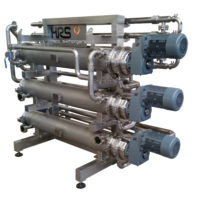Shigella Presents Unique Challenges
By Eric Mintz, MD, MPH
Team Lead, Diarrheal Diseases Epidemiology
Enteric Diseases Epidemiology Branch
Division of Foodborne, Bacterial and Mycotic Diseases
Centers for Disease Control and Prevention (CDC)
Q: Give a general overview of Shigella’s incidence in food/meat products, how it is transmitted via that avenue and what the symptoms of shigellosis are.
Mintz: Shigella is a bacterium that uniquely infects humans and higher primates. It has no animal or environmental reservoirs or other hosts. Therefore it is introduced into foods only by contamination with human waste — either through contact with water or surfaces that have been contaminated with human sewage, or by contact with the unwashed hands of an infected person. Shigellosis causes watery or bloody diarrhea, generally accompanied by fever. The most common cause of shigellosis in the U.S. is Shigella sonnei, which accounts for about 85 percent of the 13,000 or so cases of shigellosis that are laboratory confirmed in the U.S. and reported to CDC each year. Many cases occur in young children in association with outbreaks in child-care centers, where toileting and hygiene practices are not optimal.
Foodborne outbreaks of shigellosis do occur, and are most often associated with produce and other foods that are eaten raw and that have become contaminated during processing or preparation. Ninety foodborne outbreaks of shigellosis resulting in 5,759 illnesses, 158 hospitalizations, and one death were reported to CDC between 1998 and 2004. About 60 percent of outbreaks were caused by foods prepared and eaten at restaurants. Salads accounted for 31 percent, and “dips” accounted for 26 percent of the 39 outbreaks in which a specific food item was implicated as the vehicle.
One strain of the bacterium, Shigella dysenteriae type 1, produces the same toxin as E. coli O157:H7, and can cause hemolytic uremic syndrome (HUS), renal failure and death. Fortunately, this strain is very rare in the U.S.
Q: What are the best ways that food/meat processors can avoid harboring or transmitting this germ via its products?
Mintz: The best ways that food/meat processors can avoid harboring or transmitting this germ is to follow strict precautions regarding water quality for irrigating, icing and washing produce; to ensure that all foodhandlers enjoy adequate access to sanitary toileting facilities and practice proper handwashing procedures; and to not allow foodhandlers who are ill to work or come in contact with foods or utensils. Fly control is also important, as flies can be a mechanical vector for Shigella to travel from feces to food.
Q: Are those processors doing a good job of limiting and/or preventing shigellosis outbreaks from occurring as a result of consumption or handling of their products?
Mintz: Restaurants, in particular, could do a better job of preventing contamination of foods with Shigella during preparation and service. Produce growers and distributors also need to encourage better worker hygiene and more careful monitoring of water quality used for processing produce from farm to factory.
Q: What challenges do scientists and food-safety technicians (and the like) face in terms of prevention of the spread of Shigella via the food supply?
Mintz: There is no available vaccine for shigellosis and it is easily transmitted from person to person or via foods. Increasingly, Shigella bacteria have acquired resistance to many currently available antimicrobial agents used for treatment. Changing behavior to improve handwashing and hygiene practices is essential to curbing the spread of shigellosis, but is not easy to do.




Report Abusive Comment